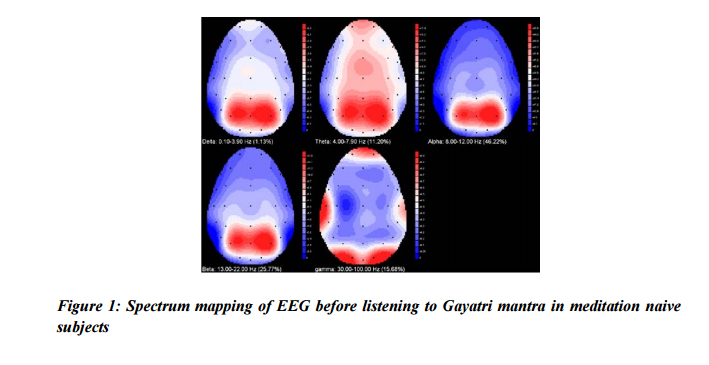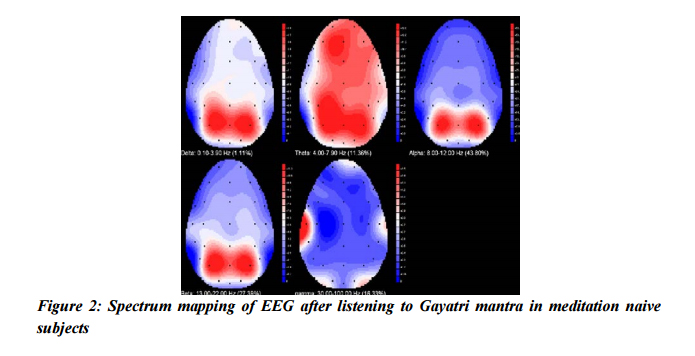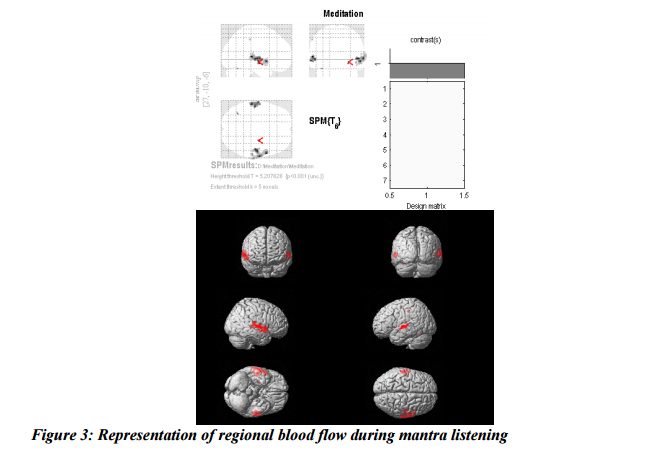
Susan Thomas, Shobini L. Rao
Abstract : A mantra is a word or phrase repeated aloud or silently and used to focus attention. Meditation using mantras is widely practiced in India. However, research on the effects of mantra meditation on the brain is sparse. The aim was to study the effect of listening to Gayatri mantra on the brain using Elecroencephalograph (EEG) functional Magnetic Resonance Imaging (fMRI). Sample included 8 meditation naive subjects, who have not been practicing any form of meditation. There were 12 subjects for the EEG study and 8 subjects for the fMRI study. The results showed that the areas that had maximum activation were the bilateral superior temporal gyri, right temporal lobe, right insula, left inferior parietal lobule, lateral globuspallidus and culmen of the cerebellum. There were some EEG changes before and after listening to Gayatri mantra also, but reliable analysis could not be carried out due to the less number of samples. Results indicate that mantra meditation can result in changes in the brain.
The word meditation is used to describe practices that are used to regulate the body and mind, thereby affecting mental or physical events this is often achieved by using a specific attentional set. It is an all inclusive term that includes practices that have some common features, but are different in the way they are practiced or observed. Very often the aim of these practices is to calm the mind or reach a different level of consciousness like hypnosis, progressive relaxation, and trance-induction techniques. In an evidence report by the Agency for health care research and Quality, U.S.A, meditation practices are classified into five categories, Mantra meditation, Mindfulness meditation, Yoga, Tai Chi, and Qi Gong. A mantra is a word or phrase repeated aloud or silently and used to focus attention. In research, mantra meditation is used synonymously with transcendental meditation in spite of differences between them. Transcendental meditation is a highly standardized procedure which involves a personal mantra and seven steps to reach transcendence. It is a form of mantra meditation. Mantra meditation involves the repetition of a phrase or mantra with the concept of surrendering and renunciation. It has religious implications.
Since meditation has a relaxation component to it, it is believed to influence brain wave patterns. Electro Encephalogram is the recording of brain wave patterns. EEG meditation studies have found power increases in theta and alpha bands. Additional findings of increased power coherence and gamma band effects with meditation are starting to emerge. However meta analysis and review studies have concluded that the studies on the effects of meditation on EEG are not consistent (Cahn and Pollich, 2006; Agency for Healthcare Research and Quality, 2007). Research on the effects of mantra meditation as it is generally practiced in India is sparse. The single study on mantra meditation found improvement in EEG with mantra meditation in epileptics (Deepak et al, 1994).
The other are of investigation in meditation used fMRI. Lazar et al (2005) compared 20 individuals trained in insight meditation for an average of 9.1 years to 15 normal controls who did not have any exposure to meditation or yoga using MRI technique. They showed that the right anterior insula and prefrontal cortex was thicker in meditators. Holzel et al (2007) conducted an MRI study on 20 Vipassana meditators with mean practice of 8. 6 years and compared that to 20 non meditators matched on age, sex, education and handedness. Using region of interest analysis, they found analyses, gray matter concentration in the right hippocampus and right anterior insula was significantly greater in meditators. Lutz et al (2008) conducted an fMRI study to investigate the effects of compassion meditation in the brains of 16 Buddhist monks in comparison to 16 healthy volunteers. Significant activity was observed in the right insula of the brain when the long-term meditators were meditating.
The effects of mantra meditation on the brain is not clearly understood. The present study aims to do devise a paradigm for the same as part of a pilot study
MATERIALS AND METHODS
Aim: The aim of the present study was to examine the brain mechanisms in Mantra meditation using EEG and FMRI. Sample: The sample included meditation naïve subjects, who have not been practicing any form of meditation. 12 subjects underwent the EEG examination 8 subjects underwent fMRI investigation. The age range was 20-35 years and did not have any significant medical, psychiatric, neurological or neurosurgical disorders. Informed consent was obtained from the participants, after explaining about the study. The method is divided into that for the EEG study and fMRI study
EEG study
A 32 channel EEG recording was done which includes a 3 minute eyes closed phase, 15 minutes mantra listening phase and another 3 minute eyes closed phase. The subjects listened to Gayatri mantra during the meditative phase. The EEG thus obtained was analysed using the (Fast Fourier Transform) FFT method, and a spectrum analysis was done. The pre meditation EEG and the post meditation EEG were compared.
fMRI study
A block design paradigm was developed, with two rest phases and two active phases of 5 minutes duration each using E prime. Gayatri mantra was presented repeatedly through the auditory modality during the active phase and fade-in and fade out of white noise during the rest phase. The total duration was 22 minutes. 3T Skyra MRI system was used for scanning, and the fMRI was carried out using IFIS software. The images were analysed using Statistical Parametric Mapping (SPM 8) software. The brain areas that corresponded to the activations were plotted using Talaraich coordinates, to obtain the Brodman areas.
RESULTS
EEG study: The EEG study showed that the percentage of gamma and beta waves increased in the post Gayatri mantra listening phase with respect to the pre Gayatri mantra listening phase (vide figure 1 &2). Expert Buddhist meditators are found to have a predominance of high frequency gamma waves in their EEG.


fMRI study : The results showed that the areas that had maximum activation were the bilateral superior temporal gyri, right temporal lobe, right insula, left inferior parietal lobule, lateral globuspallidus and culmen of the cerebellum (figure 3).

DISCUSSION
It is hypothesised that activation in the bilateral superior temporal gyri is due to processing of auditory stimuli and language and the right temporal lobe due to processing of prosody. Activation in the left inferior parietal lobule cannot be attributed to semantic processing, as the subjects except one were not aware of the meaning of the mantra. It may be due to temporal sequencing inherent to recitation of mantras. Activation in basal ganglia and culmen is hypothesised to be due to subvocal motor activity. Right insula mediates bodily self awareness and emotional experience. Studies have found that the insula is significantly thicker in experienced meditators (Lazar et al, 2005). This may be due to repeated activation of the insula that it becomes thicker in experienced meditators.
Conclusions: For novice meditators, restlessness can arise due to continuous listening to Gayatri mantra. Duration of 10-15 minutes is found to be optimum. There is a minimal increase in the percentage of gamma waves of meditation naive normal volunteers after listening to Gayatri mantra for 15 minutes. In fMRI, the brain areas that were activated in meditation naive normal volunteers during listening to Gayatri mantra included right insula, which is involved in bodily self awareness and emotional experience. The paradigms developed during both studies were found useful in examining brain changes during meditation.
REFERENCES:
Agency for Healthcare Research and Quality .(2007). Mediation Practices for Health: State of the Research. AHRQ Publication No. 07-E010.Rockville, USA.
Cahn, B.R. and Polich, J. (2006).Meditation States and Traits: EEG, ERP, and Neuroimaging Studies. Psychological Bulletin ,132( 2), 180–211.
Deepak, K. K., Manchanda, S. K., &Maheshwari, M. C. (1994). Meditation improves clinic electroencephalographic measures in drug-resistant epileptics. Biofeedback and Self Regulation, 19, 25–40.
Holzel, B.K., Ott, U., Gard. T., Hempel, H., Weygandt, Morgen, K and Vaitl, D. (2007).Investigation of mindfulness meditation practitioners with voxel-based morphometry.Social, Cognitive and Affective Neuroscience, 3(1): 55-61
Lazar, S.W., Kerr, C.E., Wasserman, R.H., Gray, J.R., Greve, D.N., Treadway, M.T., McGarvey, M., Quinn, B.T., Dusek, J.A., Benson, H., Rauch, S.L., Moore, C.I. and Fischl, B. (2005). Meditation experience is associated with increased cortical thickness. Neuroreport, 16 (17): 1893-1897
Lutz, A., Brefczynski-Lewis, J., Johnstone, T and Davidson, R.J .(2008). Regulation of the Neural Circuitry of Emotion by Compassion Meditation: Effects of Meditative Expertise. PLoS ONE, 3(3), e1897. Doi:10.1371/journal.pone.00011897.



